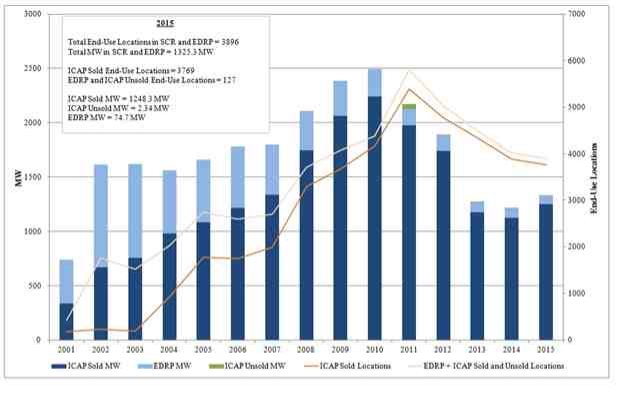
10 Krey Boulevard Rensselaer, NY 12144
THIS FILING LETTER DOES NOT CONTAIN ANY PRIVILEGED OR
CONFIDENTIAL INFORMATION. ATTACHMENT I - THE BODY OF REPORT,
ALONG WITH THE REDACTED VERSIONS OF TABLES 2 THROUGH 5 (MARKED PUBLIC) DOES NOT CONTAIN ANY PRIVILEGED OR CONFIDENTIAL
INFORMATION. ATTACHMENT II - CONFIDENTIAL TABLES AND DEMAND SIDE ANCILLARY SERVICES PROGRAM DETAILS, INCLUDES THE
UNREDACTED TABLES, WHICH CONTAIN PRIVILEGED AND CONFIDENTIAL INFORMATION, AND IS SUBMITTED SEPARATELY.
January 12, 2016
Kimberly D. Bose, Secretary
Federal Energy Regulatory Commission 888 First Street, N.E.
Washington, D.C. 20426
Re: Annual Report in Docket No. ER01-3001-000;
Request for Privileged Treatment of Attachment II
Dear Ms. Bose:
Enclosed for filing in the above-referenced docket is the New York Independent System
Operator, Inc.’s (“NYISO”) annual report to the Federal Energy Regulatory Commission
(“Commission”) on the NYISO’s Demand Side Management programs. By Order dated
February 19, 2010, the Commission directed the NYISO to file this report for informational
purposes only.1
I. List of Documents Submitted
The NYISO submits this filing letter, accompanied by: (i) Attachment I, the NYISO 2015
Annual Report on Demand Response Programs, which includes redactions in Tables 2 through 5
of confidential, commercially sensitive information, and (ii) Confidential Attachment II, which
contains the unredacted versions of Tables 2 through 5. Confidential Attachment II also contains
an update on the status of resources participating in the NYISO’s Demand Side Ancillary Service
Program.
1 New York Independent System Operator, Inc., Letter Order, Docket Nos. ER01-3001-021, et al. (Feb. 19, 2010).
Kimberley D. Bose, Secretary January 12, 2016
Page 2
II. Request for Confidential Treatment of Attachment II
In accordance with Sections 388.107 and 388.112 of the Commission’s Regulations,2
Article 6 of the NYISO’s Market Administration and Control Area Services Tariff, and Sections
12.1(4) and 12.4 of the NYISO’s Code of Conduct in Attachment F of the NYISO Open Access
Transmission Tariff, the NYISO requests Privileged and Confidential treatment of the contents
of Attachment II to this filing letter. The NYISO also requests that the confidential Attachment
II be exempted from public disclosure under the Freedom of Information Act (“FOIA”), 5 U.S.C.
§552.3
Attachment II includes information regarding the number of demand response resources in a load zone that, when aggregated, are not greater than five (5). With such a small number of resources in the load zone, the NYISO’s aggregation of the data reported for that load zone may not sufficiently mask confidential and commercially sensitive Market Participant4 information that the NYISO does not make public. Attachment II also includes a brief discussion of the
status of enrollment and registration for the resources seeking to participate in the NYISO’s
Demand Side Ancillary Services Program. The number of resources described in this discussion similarly may not sufficiently mask confidential and commercially sensitive Market Participant information that the NYISO does not make public.
Attachment II, therefore, contains privileged, commercially sensitive, trade secret
information that is exempt from disclosure under 5 U.S.C. §552(b)(4). Disclosure of such
information could cause competitive harm to the affected Market Participants, and could
adversely affect competition in the markets administered by the NYISO. For this reason, the
NYISO requests that the contents of Attachment II receive Privileged and Confidential treatment and be exempt from FOIA disclosure. Attachment II is identified and marked in accordance with the Commission’s regulations and rules published by the Secretary’s Office for submitting
Privileged information.
2 18 C.F.R. §§ 388.107 and 388.112 (2015).
3 The information provided by the NYISO for which the NYISO claims an exemption from FOIA disclosure is labeled “Contains Privileged Information - Do Not Release.”
4 Terms with initial capitalization not defined herein have the meaning set forth in the NYISO’s Market Administration and Control Area Services Tariff and Open Access Transmission Tariff.
Kimberley D. Bose, Secretary January 12, 2016
Page 3
III. Correspondence
Copies of correspondence concerning this filing should be addressed to:
Robert E. Fernandez, General Counsel
Raymond Stalter, Director of Regulatory Affairs * Gregory J. Campbell, Attorney
New York Independent System Operator, Inc.
10 Krey Boulevard
Rensselaer, NY 12144
Tel: (518) 356-6000
Fax: (518) 356-4702
rfernandez@nyiso.com
rstalter@nyiso.com
gcampbell@nyiso.com
* -- Persons designated for service.
*Ted J. Murphy
Hunton & Williams LLP
2200 Pennsylvania Avenue, NW Washington, D.C. 20037
Tel: (202) 955-1500
Fax: (202) 778-2201
tmurphy@hunton.com
Kevin W. Jones
*Michael J. Messonnier, Jr.5 Hunton & Williams LLP
951 East Byrd Street
Richmond, VA 23219
Tel: (804) 788-8200
Fax: (804) 344-7999
kjones@hunton.com
mmessonnier@hunton.com
5 The NYISO respectfully requests waiver of 18 C.F.R. § 385.203(b)(3) (2011) to permit service on counsel for the NYISO in both Washington, D.C. and Richmond, VA.
Kimberley D. Bose, Secretary January 12, 2016
Page 4
IV. CONCLUSION
WHEREFORE, the New York Independent System Operator, Inc. respectfully requests that the Commission accept this informational filing and treat the contents of Attachment II as Privileged and Confidential and exempt from FOIA disclosure.
Respectfully submitted,
/s/ Gregory J. Campbell
Attorney
New York Independent System Operator, Inc.
10 Krey Boulevard
Rensselaer, New York 12144 (518) 356-8540
cc:Michael Bardee
Anna Cochrane
Kurt Longo
Max Minzner
Daniel Nowak
Larry Parkinson
J. Arnold Quinn
Douglas Roe
Kathleen Schnorf
Jamie Simler
Gary Will
CERTIFICATE OF SERVICE
I hereby certify that I have this day served the foregoing document upon each person
designated on the official service list compiled by the Secretary in this proceeding in accordance
with the requirements of Rule 2010 of the Rules of Practice and Procedure, 18 C.F.R. §
385.2010.
Dated at Rensselaer, NY this 12th day of January 2016.
By:/s/ John C. Cutting
John C. Cutting
New York Independent System Operator, Inc.
10 Krey Blvd.
Rensselaer, NY 12144 (518) 356-7521
NYISO 2015 Annual Report on Demand Response Programs
I.Program Descriptions
The New York Independent System Operator, Inc. (“NYISO”) administers four demand response programs for the dual purposes of system reliability and to reduce overall production
costs. The Emergency Demand Response Program (“EDRP”)1 and the Installed Capacity -
Special Case Resource (“ICAP/SCR”) program support the reliability of the NYISO system.
Both programs are designed to reduce power consumption by directing demand response
resources to reduce load or use qualified Local Generators to remove load from the system
during grid emergencies or when additional generation supply is limited. Loads supplied by the NYS Transmission and/or distribution system are eligible to take part in these programs, and
aggregators enroll Demand Side Resources and coordinate with the NYISO to notify resources when the NYISO deploys demand response.
The NYISO also offers two economic demand response programs, the Day-Ahead
Demand Response Program (“DADRP”) in its Energy market, and the Demand-Side Ancillary
Services Program (“DSASP”) in the Ancillary Services market. The DADRP allows Loads
supplied by the NYS Transmission and/or distribution system to offer their load reductions into
the Day-Ahead Energy market as a supply resource. This program allows flexible loads to
effectively increase the amount of supply in the market and moderate prices. The DSASP
provides program participants with an opportunity to offer their load curtailment capability into
the Day-Ahead Market (“DAM”) and/or Real-Time Market (“RTM”) to provide Operating
Reserves and Regulation Service. Each of these four programs is described in greater detail
below.
Emergency Demand Response Program
The NYISO’s EDRP offers Demand Side Resources an opportunity to earn the greater of
$500/MWh or the prevailing Locational-Based Marginal Price (“LBMP”) for curtailing energy
consumption when called upon to reduce Load by the NYISO. EDRP resources are enrolled by
Curtailment Service Providers (“CSPs”), which serve as the interface between the NYISO and
resource.2 Load curtailment by EDRP resources during NYISO-called events is voluntary.
1 Capitalized terms not defined herein have the meaning ascribed to them in the NYISO’s Market Administration and Control Area Services Tariff (“Services Tariff”).
2 An individual EDRP resource may, if it meets the applicable registration requirements, act as its own CSP.
1
Installed Capacity - Special Case Resource Program
Special Case Resources (“SCRs”) are a type of demand side resource that meet certain
eligibility requirements and may offer Unforced Capacity (“UCAP”) into the NYISO’s ICAP
market as capacity supply resources. SCRs are enrolled by Responsible Interface Parties
(“RIPs”) which may aggregate individual SCRs and serve as the interface between the NYISO
and the resources.3 Resources may be enrolled in either the EDRP or the ICAP/SCR program,
but not both.
Demand response events are called by the NYISO during grid emergencies or when
reserve shortages are anticipated or actually occur. SCRs that have sold ICAP are obligated to reduce their system load when called upon by the NYISO with two or more hours notice,
provided that the NYISO notified the RIP the day before any such call to reduce their load. In addition to receiving a capacity payment, RIPs are eligible to receive energy payments during an event or test, based on hourly market prices, plus a Bid Production Cost guarantee payment to make up for any difference between the market price received and their block offer price across the day. Energy payments are calculated using the same performance calculation used by the NYISO to pay for the performance of EDRP resources.
Enrolled SCRs must verify their capability to achieve the amount of enrolled load
reduction in each Capability Period. Failure of an SCR to reduce load during an event or test may result in penalties being assessed to the applicable RIP in accordance with the NYISO’s Services Tariff and the ICAP/SCR program rules and procedures.
Targeted Demand Response Program
The Targeted Demand Response Program (“TDRP”), introduced in July 2007, is a
NYISO reliability program that deploys existing EDRP resources and SCRs on a voluntary basis in targeted subzones to solve local reliability problems at the request of a Transmission Owner . The TDRP program is currently available only in Load Zone J (New York City). RIPs are
eligible to receive energy payments during an event or test based on hourly market prices plus a Bid Production Cost guarantee. Energy payments are calculated using the same performance calculation used by the NYISO to pay for the performance of EDRP resources.
3 An individual SCR may, if it meets the applicable registration requirements, act as its own RIP.
2
Day-Ahead Demand Response Program
The NYISO’s DADRP allows Demand Side Resources to offer load curtailment into the DAM as an energy supply resource. Resources participating in the DADRP submit offers by 5:00 a.m. specifying the hours and amount of load curtailment for the following day, and the price at which they are willing to curtail. The current offer floor price is $75/MWh.
DADRP offers are structured like those of generation resources: they specify minimum and maximum run times and the hours in which they are available. Demand Side Resources with Load reductions scheduled in the DAM are obligated to curtail the next day. DADRP resources are also eligible for Bid Production Cost guarantee payments. Failure of a DADRP resource to curtail its Load may result in penalties being assessed to the applicable resource in accordance with the NYISO’s Services Tariff and the DADRP program rules and procedures.
Demand-Side Ancillary Services Program
The NYISO’s DSASP provides Demand Side Resources (that meet telemetry and other qualification requirements) an opportunity to offer their load curtailment capability into the
DAM and/or RTM to provide Operating Reserves and Regulation Service. Resources must
qualify through standard resource testing requirements in order to provide these services. Offers are submitted through the same process as generation resources: resources participating in the DAM submit offers by 5:00 a.m. specifying the Ancillary Service they are offering (Operating Reserves, and/or Regulation Service) along with the hours and amount of load curtailment for the following day, and the price at which they are willing to curtail. DSASP resources may also submit RTM offers up to 75 minutes before the hour of the offer.
The dispatch of the DSASP resources’ Operating Reserves to Energy is determined in the
RTM by the Real-Time Dispatch (“RTD”) program. When RTD instructs the DSASP resources
to provide Energy, DSASP resources will be required to decrease the Load being consumed from
the NYS Transmission System and/or distribution system. The dispatch of Regulation Service
into Energy is determined in the RTM by the Automatic Generation Control (“AGC”) program.
Depending on the system needs, the AGC may instruct DSASP resources to either increase or
decrease the Load being consumed from the NYS Transmission System and/or distribution
system.
When DSASP resources are converted to energy in the real-time, DSASP resources are
not paid for energy, but are eligible for a Day-Ahead Margin Assurance Payment to make up for
any balancing differences between their Day-Ahead Operating Reserves or Regulation Service
schedule and real-time dispatch, subject to their performance for the scheduled service.
3
Performance indices are calculated on an interval basis for both Operating Reserves and
Regulation Service. Day-Ahead Margin Assurance Payments are adjusted by the performance index for the services provided.
II.2015 Program Summary
EDRP and ICAP/SCR Program
As of July 31, 2015, a total of 30 CSPs and RIPs had eligible resources enrolled in the
NYISO’s EDRP and ICAP/SCR program.4 Participating CSPs and RIPs include:
4 Transmission Owners (“TOs”)
8 Competitive Load Serving Entities (“LSEs”) (LSEs that are not TOs)
14 Aggregators (non-LSE or TO)
4 EDRP or ICAP/SCR direct participation resources (resources that represent themselves
as the CSP/RIP)
These figures represent a decrease of a single CSP/RIP from 2014: a Competitive LSE. There was no change in the number of TOs, aggregators, or direct customers from 2014.
As of July 31, 2015, a total of 3,896 end-use locations were enrolled in the NYISO’s
EDRP and ICAP/SCR program. These locations were capable of providing a total of 1,325.4
MW of demand response. This corresponded to a 9.5% increase in the enrolled MW versus
2014, and represents 4.3% of the 2015 Summer Capability Period peak demand of 31,138 MW.
Of the 3,896 end-use locations, 116 participated in the EDRP program, eleven were ICAP/SCR
resources with unsold capacity,5 and the remaining 3,769 end-use locations participated in the
NYISO’s ICAP/SCR program. The ICAP/SCR program represents 97.0% of the total resources
enrolled in the NYISO’s reliability-based demand response programs and 94.2% of the total
enrolled MW in those programs.
Aggregators, competitive LSEs, and direct customers currently represent 82.7% of
enrolled MW in EDRP and ICAP/SCR, down from 87.5% of enrolled MW in 2014. The
4 For several years, the date customarily used for reporting the NYISO’s demand response program participation statistics was August 31. In 2011, the NYISO changed its reporting date from August 31 to July 31 to better align with several other reliability and planning reporting requirements. A July 31 reporting date also provides better transparency with other reporting requirements for the NYISO’s demand response programs. The NYISO has evaluated the difference in enrollment between July and August and found it to be de minimis (2-3%). The data provided herein is based on a snapshot of the programs on July 31, 2015.
5 ICAP/SCR Resources with unsold capacity are those resources that did not sell their full available capacity.
4
remaining 17.3% of MW are enrolled by TOs. In 2015, two non-TO market participants enrolled resources in the EDRP (out of six total EDRP participants), all other EDRP resources were
enrolled through their TO. In the ICAP/SCR program, three participants enrolled through their TO, while all other ICAP/SCR resources were enrolled through other means. Direct customers represented 4.6% of total MW in the ICAP/SCR program.
The TDRP, which deploys EDRP and ICAP/SCR resources in the various subzones in
Zone J for local reliability, includes 28.4% of the total New York Control Area (“NYCA”)
EDRP end-use locations and 19.0% of total NYCA EDRP MW. The TDRP also includes 49.3%
of total NYCA ICAP/SCR end-use locations, representing 30.8% of the total NYCA ICAP/SCR
MW.
Since 2003, when participation in EDRP and ICAP/SCR became mutually exclusive,
EDRP end-use locations and enrolled MWs have continued to decline. ICAP/SCR aggregations
by RIPs now account for 98.2 % of ICAP/SCR resources and 76.9% of enrolled MW in the
program.
During the 2015 Summer Capability Period, the NYISO did not deploy either of its
reliability demand response programs. The NYISO also did not receive a request to deploy the TDRP program during this period.
Day-Ahead Demand Response Program
DADRP enrollment has been static for several years and enrolled resources have shown no activity in the energy market for more than four years. Given no activity during the analysis period, there is no market participation to report. DADRP enrollment remained unchanged since the January 2015 Report.
Demand-Side Ancillary Service Program
There are three demand side resources actively participating in the DSASP as providers of Operating Reserves. The resources represent 126.5 MW of capability and had an average performance of 144% during the analysis period of May 2015 through October 2015.
Additional detailed information on participation in the DSASP is found in confidential Attachment II.
5

III.Reliability Program Participation Detail
Historical Enrollment Data
Historical enrollment data for the NYISO’s reliability demand response programs is
presented in Figure 1. The figure plots the enrollment in the NYISO’s reliability-based programs from inception through July 2015. The stacked bar charts plot enrolled MW by program and year, and the lines plot the number of end-use locations by program and year.
From May 2001 through July 2015, combined enrollment in EDRP and ICAP/SCR has grown from approximately 200 MW to 1325.4 MW. The total number of end-use locations has increased from approximately 200 in March 2001, to 3,896 in July 2015. Since participation in EDRP and ICAP/SCR program became mutually exclusive in 2003, the number of participating EDRP resources, and the MW they contribute, has decreased.
Figure 1: Historical Enrollment of
End-Use Locations and MW in NYISO Reliability Programs
6
Changes in Program Enrollment - 2014 - 2015
Enrollment data for the NYISO’s Reliability-based demand response programs in 2014 and 2015 is provided in Table 1. The number of end-use locations has declined in both the EDRP and ICAP/SCR program since the 2014 report; however, the enrolled MW in the
ICAP/SCR program has increased.
Table 1: Program Enrollment by End-Use Location - 2014 - 2015
20152014
Percent Change
From 2014 to 2015
MW per End-Use Location
MWLocationEnrolledPercent
CountMWCountMWChangeCountMW20152014Change
EDRP11674.713485.6-10.9-13%-13%0.60.640.8%
Unsold112.3490.721.622%225%0.210.08165.8%
ICAP Sold37691248.338791124.4123.9-3%11%0.30.2914.3%
Figures 2 and 3 present enrollment statistics in the EDRP and ICAP/SCR program from
2001 - 2015. Figure 2 presents the data by MW enrolled, while Figure 3 presents the data by
number of end-use locations.6 The reductions in enrolled MW and in end-use locations in recent
years are due in part to changes in market rules designed to better estimate the demand response
capability available to the NYISO under peak load conditions. Notable, however, the enrolled
MW in the ICAP/SCR program increased between 2014 and 2015. Since making the EDRP and
ICAP/SCR program mutually exclusive, there has been a general decline in the number of
enrolled MW and resources in the EDRP.
6 ICAP/SCR program enrollment of individual end-use locations began in 2004. In 2001 and 2002 end-use locations could enroll in both the EDRP and ICAP/SCR program, but beginning in 2003, resources were prohibited from
simultaneously enrolling in both programs.
7
Figure 2: Enrollment in the NYISO’s EDRP and ICAP/SCR
Program by MW, 2001 - 2015
2500
2000
1500
1000
500
0
2001 2002 2003 2004 2005 2006 2007 2008 2009 2010 2011 2012 2013 2014 2015
EDRP MWICAP Unsold MWICAP Sold MW
8
Figure 3: Enrollment in the NYISO’s EDRP and ICAP/SCR
Program by End-Use Location, 2001 - 2015
6000
5000
4000
3000
2000
1000
0
2001 2002 2003 2004 2005 2006 2007 2008 2009 2010 2011 2012 2013 2014 2015
ICAP Sold LocationsEDRP + ICAP Unsold Locations
2014 - 2015 EDRP and ICAP/SCR Program Enrollments
At the end of July 2015, 3,896 end-use locations, with a total of 1,325.4 MW of demand
response capability, were enrolled in NYISO’s EDRP and ICAP/SCR program. This represents
a 9.5% increase from the total enrolled demand response capability in 2014. Of the 3,896 end-
use locations, 116 enrolled in the EDRP and 3,780 enrolled in the ICAP/SCR program.
ICAP/SCR resources represent 97.0% of the total reliability program end-use locations and
94.2% of the total reliability program MW. The proportion of ICAP/SCR program enrolled capability to total reliability program capability has increased marginally since 2014. Table 2, below, provides summary data for the EDRP and ICAP/SCR program.
9
Table 2: Program Enrollment Summary by CSP and RIP Type
EDRPICAP UnsoldICAP Sold
No. of
UniqueAgent Type
MPs
No. of
CSPs
No. of
No. of
End-UseMW
RIPs Locations
No. ofNo. of
No. of
End-UseMWEnd-UseMW
RIPs
Locations Locations
14Aggregator000.07102.24143607937.6
Direct
4Customer000.0000.00*860.7
Competitive
Load Serving
8Entity*112.5000.00811993.1
Transmission
4Owner/LSE*10572.2**0.10*35156.9
30Total611674.78112.342837691248.3
*Entries in this category have been masked for confidentiality in the public version of this table. The unredacted values are presented in the confidential appendix submitted as Attachment II.
2015 EDRP enrollments were predominantly through TOs, contrasted with the
ICAP/SCR program where non-TOs provided 96.4% of participating end-use locations and
82.7% of the enrolled MW.
Table 3 provides additional program enrollment detail by Load Zone. Although the
NYISO does not collect specific resource class data, demand response resources in Load Zones A through E are typically industrial and retail resources, while those in Load Zones J and K include commercial office, retail, and multi-family residential resources.
Table 3: 2015 Program Enrollment by Load Zone
EDRPICAP UnsoldICAP Sold
No. ofNo. ofNo. of
ZoneEnd-UseMWEnd-UseMWEnd-UseMW
LocationsLocationsLocations
A1213.400.00359314.5
B*1.800.0022484.4
C2211.300.00273111.0
D73.400.002259.4
E125.9*0.1013439.8
F2022.600.00200107.9
G00.0*0.0116853.3
H*1.600.00245.9
I*0.0*0.189121.1
J3314.2*1.051858384.0
K*0.5*1.0041667.0
Total11674.7112.3437691248.3
*Entries in this category have been masked for confidentiality in the public
version of this table. The unredacted values are presented in the confidential appendix submitted as Attachment II.
10
ICAP/SCR Resource Aggregations
ICAP/SCR resource enrollments are identified by the NYISO by end-use location, and
may represent either individually enrolled end-use locations or aggregations of end-use locations that are enrolled as a single demand response resource. Table 4, below, provides data on
ICAP/SCR program participation. As of July 31, 2015, 3,780 end-use locations are enrolled in aggregations. These aggregations provide 962.0 MW of the 1,250.7 MW enrolled in the
ICAP/SCR program. The remaining 288.6 MW of demand response capacity in the ICAP/SCR program comes from 72 individually enrolled resources.
Table 4: Detail of 2015 ICAP/SCR Program Participation Level by Resource Type
ICAP SoldICAP Unsold
Resource Type
No. of End-Use
Locations
No. of End-Use
MWMW
Locations
Individual Resources67288.3*0.39
Aggregated Resources3702960.161.95
Total37691248.3112.34
*Entries in this category have been masked for confidentiality in the public version of this table. The unredacted values are presented in the confidential appendix submitted as Attachment II.
Table 4 also provides information for ICAP/SCR resources that did not sell any capacity in the July 2015 capacity market auctions. This information is included because when an
ICAP/SCR resource offers its load reduction in a NYISO auction, and that load reduction is not sold (or when a resource’s derated MW value is zero), the resource’s enrolled capacity is
automatically included in the EDRP.7
TDRP Enrollment
Load Zone J is currently the only Load Zone with resources participating in the TDRP.
This Load Zone has been divided into subzones designated by Consolidated Edison Company of
New York, Inc. (“Con Edison”). Resources enrolled in the EDRP and ICAP/SCR program are
7 The resource will remain in the EDRP until it clears in a subsequent auction, or the resource confirms a bilateral transaction with an LSE. The EDRP enrollment totals and event response data included in this report include the offered, but unsold, MW of enrolled ICAP/SCR resources.
11
assigned to one of the various subzones based on their location.8 Resources that are not assigned to a particular subzone remain in the general Zone J category. Tables 5 and 6 provide EDRP and ICAP/SCR end-use locations and MW enrolled in the TDRP by subzone.
Table 5: EDRP End-Use Locations Enrolled in TDRP
Zone/SubzoneJJ1J2J3J4J5J6J7J8J9Total
MW0.10.40.60.30.20.20.30.00.312.014.2
No. of End-
Use Locations*6*7*7*0**33
* Entries in this category have been masked for confidentiality in the public version of this table. The unredacted
values are presented in the confidential appendix submitted as Attachment II.
Table 6: ICAP/SCR End-Use Locations Enrolled in TDRP
Zone/SubzoneJJ1J2J3J4J5J6J7J8J9Total
MW25.826.527.644.828.929.159.352.690.30.0385.1
No. of End-
Use Locations1831291553296817220124138501863
Analysis of ICAP/SCR Strike Prices
Starting in 2003, resources participating in the ICAP/SCR program were required to
provide a curtailment strike price - between $0 and $500/MWh - to the NYISO at the time of
enrollment. Strike prices can be used by the NYISO to determine which resources it calls in a
given event if all resources in a Load Zone or Zones are not needed to restore system security to
its equilibrium state. Strike Prices are also used in the calculation of energy payments.
The NYISO has analyzed strike price curves for all resources enrolled in July 2015 and
compared the most recent strike price curves to prior years. Figures 4 and 5 below map the
percentage of enrolled ICAP/SCR MW at a given strike price. Figure 4 illustrates the strike
price curves for the period 2003 to 2015, the entire period in which resources were required to
provide strike prices. The steep slope of the strike price curves indicate that strike prices are
clustered close to the offer ceiling of $500/MWh. The data indicates that, as the program has
evolved since 2003, the number of resources providing strike prices at or near $500/MWh has
increased, with more than 98% of enrolled ICAP/SCR MW submitting a strike price at the
$500/MWh limit.
8 The Load Zone J Subzones are: J1 - Sherman Creek/Parkchester/E 179th; J2 - Astoria West/Queensbridge; J3 -
Vernon/Greenwood; J4 - Staten Island; J5 - Astoria East/Corona/Jamaica; J6 - W 49th; J7 - East 13th/East River; J8
- Farragut/Rainey; and J9 - Shared Subzone.
12
400
350
300
250
200
150
100
50
0
2015 (1248.3 MW)
2014 (1124.4 MW)
2013 (1175.2 MW)
2012 (1741.1 MW)
2011 (1976.2 MW)
2010 (2238.5 MW)
2009 (2060.6 MW)
2008 (1743.8 MW)
2007 (1338.5 MW)
2006 (1216.2 MW)
2005 (1083.8 MW)
2004 (980.8 MW)
2003 (758 MW)
0%25%50%75%100%
% of Total MW
Figure 5 provides a detailed view of the strike price curves for 2011 through 2015. The
Figure displays a limited range where the price curve levels off to the offer ceiling of $500/MWh.
13
500
450
400
350
300
250
200
150
100
50
0.4%
0
0%
1.4%
1.2%
0.5%
1%
1.8%2%2.4%2.9%
2.3%
1.7%
2%
3%
% of Total MW
2015 (1248.3 MW)
2014 (1124.4 MW)
2013 (1175.2 MW)
2012 (1741.1 MW)
2011 (1976.2MW)
4%5%
IV. 2015 Event and Test Performance: EDRP and ICAP/SCR Program
a) Event Performance
The NYISO did not deploy its EDRP or ICAP/SCR program in 2015. The NYISO also did not receive a request to deploy the TDRP during this period.
b) Test Performance
Each resource participating in the ICAP/SCR program is required to demonstrate its
ability to meet its obligated MW once in each Capability Period. The NYISO therefore
schedules a one-hour performance test in which all SCRs are called to demonstrate their ability
(the “First Performance Test”). RIPs have the option to use a SCR’s performance in an event as
a proxy for its test value in certain circumstances; otherwise, participation in the First
Performance Test is mandatory. The NYISO also schedules a Second Performance Test for
resources that meet appropriate operational characteristics. Table 7 provides details regarding
the performance tests conducted in the Winter 2014-2015 and Summer 2015 Capability Periods:
14
Table 7: ICAP/SCR SCR Performance Tests
Capability PeriodDeployment TypeProgramEvent/Test Start TimeEvent/Test End TimeZones
Winter 2014-2015First Performance TestSCR3/3/2015 16:003/3/2015 17:00C, D, E, F, G, H, I
Winter 2014-2015First Performance TestSCR3/3/2015 17:003/3/2015 18:00J, K
Winter 2014-2015First Performance TestSCR3/3/2015 18:003/3/2015 19:00A, B
Winter 2014-2015Second Performance TestSCR4/14/2015 18:004/14/2015 19:00A, B, C, D, E, F, G, H, I, J, K
Summer 2015First Performance TestSCR8/27/2015 13:008/27/2015 14:00J
Summer 2015First Performance TestSCR8/27/2015 14:008/27/2015 15:00B, C, D, E
Summer 2015First Performance TestSCR8/27/2015 15:008/27/2015 16:00A
Summer 2015First Performance TestSCR8/27/2015 16:008/27/2015 17:00F, G, H, I, K
Summer 2015Second Performance TestSCR10/8/2015 13:0010/8/2015 14:00B, I, J
Measurement of performance test response is based on the ICAP/SCR reporting rules
contained in the NYISO’s ICAP Manual. ICAP/SCR response is determined by comparing the
actual hourly interval metered load with the Average Coincident Load (“ACL”):
ICE_RED_MWgn = (ACLgm - METER_MWgn) * (1+TLFgm)
where:
ICE_RED_MWgn is the Installed Capacity Equivalent response that Resource g supplies
during hour n of an SCR event or test;
ACLgm is the ACL for Resource g applicable to month m, using data submitted in its Special
Case Resource certification;
METER_MWgn is the metered hourly-integrated load for Resource g in hour n of an SCR
event or test; and
TLFgm is the Transmission Loss Factor for Resource g applicable to month m, using data
submitted in its Special Case Resource certification
The resource’s Installed Capacity Equivalent response is then compared with the resource’s Installed Capacity Equivalent of the maximum registered megawatt value to determine the resource’s performance.
Table 8 provides a summary of ICAP/SCR program resources’ performance test response
compared to the Obligated MW for the zones deployed during the tests. Obligated MW is
defined as the Installed Capacity Equivalent of the maximum registered megawatt value that
each SCR is required to demonstrate once in every Capability Period. Performance test MW
response reported for each Capability Period includes MW response in both First and Second
Performance Tests, if data is available. For resources that are required to demonstrate
performance in both First and Second Performance Tests, the maximum MW response is
15
reported. If Verified ACL data is not available at the time of reporting for a resource enrolled
with either a Provisional ACL or an Incremental ACL, the ACL with which the resource enrolled in the SCR program is used for reporting performance data.
Table 8: Summary of ICAP/SCR Program Performance Test MW Response Based on
ACL Baseline
ProgramCapability PeriodZones
ICAP
Equivalent ofObligated
ResponseICAP MW
MW
% Response of
Obligated
ICAP MW
SCR (ICAP)Winter (2014-2015)A,B,C,D,E,F,G,H,I,J,K942.6982.595.9%
SCR (ICAP)Summer (2015)A,B,C,D,E,F,G,H,I,J,K1643.81321.5124.4%
Table 9 provides a summary of Installed Capacity Equivalent of SCR response by Load Zone based on ACL baseline for the Winter 2014 - 2015 and Summer 2015 Capability Period performance tests.
16
Table 9: ICAP/SCR Program Performance Test MW Response Based on ACL Baseline
ProgramCapability PeriodZone
ICAP EquivalentObligated
of Response MW ICAP MW
% Response of
Obligated
ICAP MW
SCR (ICAP) Winter (2014-2015)
F65.764.7101.5%
G 36.0 40.7 88.4%
ProgramCapability Period
Zone
ICAP Equivalent
of Response MW
Obligated
ICAP MW
% Response of
Obligated
ICAP MW
SCR (ICAP)Summer (2015)
F129.3
G 69.2
110.4117.2%
56.9 121.6%
Total1643.81321.5124.4%
In addition to receiving a capacity payment for committing to reduce energy
consumption, RIPs with resources enrolled in the ICAP/SCR program are eligible to receive
energy payments for reductions made by those resources during a performance test provided that
the RIPs submit the required performance data. The amount of load reduction eligible for an
energy payment is computed using a Customer Baseline Load (“CBL”). Unlike the ACL
baseline which uses Load data from a SCR’s prior-like Capability Period, the CBL uses data
from the previous 30 days to establish a baseline which is likely to be a more accurate
17
representation of the resource’s Load during a performance test or event but for the resource’s response to the NYISO’s deployment directive. The amount of an energy payment is the
difference between the hourly CBL and the corresponding interval meter readings during
performance test hours, multiplied by the applicable LBMP.
Table 10 presents a summary of voluntarily reported CBL data by zone and hour for
ICAP/SCR resources for the Winter 2014 - 2015 and Summer 2015 Capability Period
performance tests. Since the ICAP/SCR ACL values described above are based on the prior like Capability Period, and the CBL is determined from data that ranges from 14 to 30 days prior to
the tests, the NYISO expects different response rate data. Contributing to the difference between the ICAP/SCR ACL response and the CBL response is the fact that not all RIPs submit CBL
energy performance data. The NYISO has observed that some RIPs report CBL data only for
their larger resources, and particularly in Load Zone J, where energy prices are typically higher
than in the rest of the NYCA.
18
Table 10: ICAP/SCR Program Performance Test MW Response Based on CBL Baseline
ProgramCapability Period
Zone
ICAP equivalent
of Response MW
Obligated ICAP% Response
MW of SCRsof Obligated
Reporting CBL ICAP MW
SCR (ICAP) Winter (2014-2015)
F65.3
G 29.6
59.6109.6%
40.672.8%
ProgramCapability PeriodZone
ICAP equivalent
of Response MW
Obligated ICAP% Response
MW of SCRsof Obligated
Reporting CBL ICAP MW
SCR (ICAP)Summer (2015)
F110.3107.7102.4%
G 53.5 56.0 95.5%
Total1203.61247.396.5%
19
V. Economic Demand Response Programs
Day-Ahead Demand Response Program
During the analysis period of August 2014 through July 2015, there was no activity in the DADRP. There is, therefore, nothing to report for this period.
Demand Side Ancillary Services Program
Detailed information on the DSASP is provided in Confidential Attachment II.
VI. Update on 2015 Demand Response Initiatives
This section provides an update on the status of initiatives that the NYISO has been
working on with its stakeholders to improve the administration of its demand response programs and to address regulatory directives to facilitate market participation. In particular, the NYISO has focused on:
Continued Development of the Demand Response Information System (“DRIS”) Metering Infrastructure Requirements for Demand Response
Developing a potential alternative market design to recognize the value of demand
response in the NYISO’s capacity market if demand response is determined to be nonFERC jurisdictional
Continued Development of the Demand Response Information System
The NYISO successfully deployed software improvements to DRIS in 2015. A Q2 2015 deployment incorporated the revisions to the ICAP/SCR program to allow performance in a
mandatory event to fulfill the mandatory test requirement. A Q4 2015 deployment included
upgrades to DRIS that enhanced the user interface and assisted the NYISO in administering the demand response programs.
Metering Infrastructure Requirements for Demand Response
The NYISO developed the functional requirements for the infrastructure to support communications and the collection and management of demand response meter data.
20
Development of an Alternative Market Design to Recognize Demand Response in the NYISO’s Capacity Market
Given the uncertain future of FERC-jurisdictional demand response programs as a result
of the United States Court of Appeals for the D.C. Circuit decision in EPSA v. FERC,9 and the
United States Supreme Court Review of that decision, the NYISO engaged its stakeholders in the
development of an alternative market design that would, if needed, recognize the value of
demand response in the NYISO’s capacity market if demand response programs are determined
to be non-FERC jurisdictional. The NYISO developed the concepts and associated draft tariff
language in Q1 and Q2 2015, and presented the results to stakeholders at joint Installed Capacity,
Market Issues and Price-Responsive Load Working Group meetings from February through May
2015.
Demand Response in the Real-Time Energy Market
As a result of the May 23, 2014 United States Court of Appeals for the DC Circuit
decision in EPSA v. FERC,10 and at the request of stakeholders, the NYISO has postponed
further development of market rules that would allow demand response to participate in the real-
time energy market until the EPSA matter has been resolved. The NYISO redirected its efforts
to define the metering communications infrastructure that would be needed to support real-time
communication for demand response and expanded after-the-fact meter data reporting.
VII. 2016 Demand Response Initiatives
This section provides an overview of the projects that the NYISO has planned for its demand response programs for 2016.
Continued Development of the Demand Response Information System
The NYISO is currently planning one software deployment for DRIS in 2016. A Q2
2016 deployment will enhance DRIS software to allow incorporation of new rules to support
comprehensive scarcity pricing in the NYISO’s markets.11 This deployment will also include an upgrade to the software version used by the DRIS to place automated phone calls for DR event
notifications.
9 Elec. Power Supply Ass’n v. FERC, 753 F.3d 216 (D.C. Cir. 2014).
10 Id.
11 New York Indep. Sys. Operator, Inc. November 30, 2015 Application, Docket No. ER16-425-000.

21












































